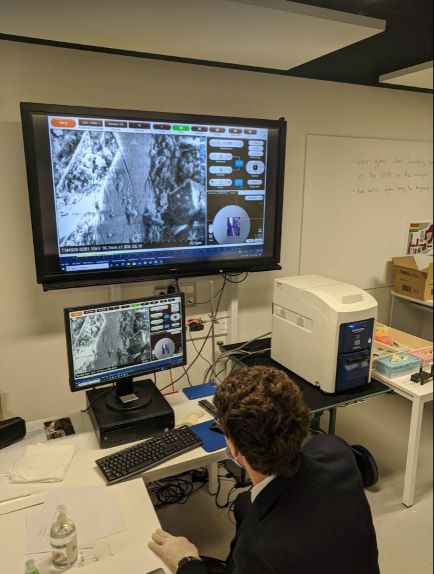Scanning Electron Microscope opens up world of discovery
Posted on 25th Mar 2021 in School News, Science
Tonbridge boys have been carrying out advanced scientific investigations thanks to the use of a Scanning Electron Microscope.
Most commonly found in leading universities, research organisations and high-tech companies, this type of microscope uses a beam of electrons to create an image of a specimen. It is capable of much higher magnifications than a light microscope, allowing it to see extremely small objects, such as the surfaces of cells and organisms, in incredibly fine and precise detail.
The instrument has been loaned to the School for several weeks by manufacturers Hitachi, as part of an education partnership with the Institute for Research in Schools, and will eventually be returned to its UK base in London’s Natural History Museum.
The Scanning Electron Microscope has enabled students to embark on advanced, independent research across all three of the sciences taught at Tonbridge, and it has also been used in lessons. Items placed under the microscope for analysis have ranged from a 2,000-year-old Roman coin to a single plankton from the Indian Ocean. It has also been used to study crystal growth and structure, and for material science projects on composition and fracture analysis.
It is possible for teachers and students to operate the microscope remotely, which has enabled Tonbridge to share this wonderful facility with a number of primary and secondary schools, including those in the local area and in places as far afield as Somerset, Nottingham and Manchester.
Phil Deakin, Head of Science at Tonbridge, said: “It has been a great privilege to be able to use the microscope and to share it with other schools, and it has definitely helped inspire our students in their research projects. Science should be all about excitement and discovery, and the results from the Scanning Electron Microscope certainly deliver on both these fronts.”
Some of those attending Tonbridge’s recent international Science Conference, which enabled students from the USA, Australia and Mexico, as well as from the UK, to meet online and share their research findings, also had the opportunity to use the microscope.
It is located in the School's Barton Science Centre, a three-storey hub for teaching and learning which was opened in 2019 by NASA astronauts. The state-of-the-art centre places Tonbridge at the cutting edge of school science both nationally and worldwide.